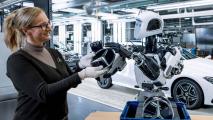The contact lens robot is for people with hand tremors, dexterity issues, or simply a fear of touching their own eyes.
Contact lens users have to have a steady hand — too much movement and they might drop the lens or poke themselves in the eye.
For the millions of people with conditions that cause hand tremors, contact lenses aren’t really an option. That’s not a big deal if they can wear glasses, but some vision problems can only be corrected with contact lenses.
Florida resident Craig Hershoff was facing that very situation, so he came up with a solution to the problem: a contact lens robot that could do the inserting and extracting of lenses for him.
A Contact Lens Robot
In 2000, doctors diagnosed Hershoff with a disease that affects the cornea. He almost went blind from it, but with several corneal transplants and the use of a special kind of contact lens, he regained his vision.
When Hershoff’s wife died, he began experiencing hand tremors due to anxiety. Those made it difficult for him to put in and remove his contact lenses, which caused him to wonder what he would do if he eventually couldn’t put them in at all.
That concern inspired Hershoff to invent the Cliara Lens Robot (Cliara stands for “Contact Lens Insertion and Removal Apparatus”).
The contact lens robot sits on a flat surface, and a person places their contact lens on a tiny upward-facing suction cup. They then lean forward, resting their forehead on the device so that the suction cup is under their eye.
Once they activate the robot using their voice, the suction cup rises until force sensors let it know that the lens has been inserted. At that point, it drops back down.
The process for removing a lens is largely the same, but in that case, the sensors let the robot know when the tiny suction cup has extracted the lens from the eye.
Eye Witness
To make the process less nerve-wracking for users, a camera displays the movement of the contact lens robot on a screen in front of the user’s free eye.
Any type of anxiety or nervousness is gone.
Craig Hershoff
“(Y)ou can see where the lens is going and exactly how it’s being placed,” Hershoff told CNN. “Any type of anxiety or nervousness is gone because you are controlling the device and it’s extremely gentle and safe.”
Clinical trials of the contact lens robot are currently taking place in Boston, and Hershoff is hopeful that he’ll be able to secure FDA approval for the device in 2021.
If approved, he believes it could make contacts accessible to people with hand tremors, dexterity issues, or even just a fear about touching their own eyes.
We’d love to hear from you! If you have a comment about this article or if you have a tip for a future Freethink story, please email us at [email protected].





